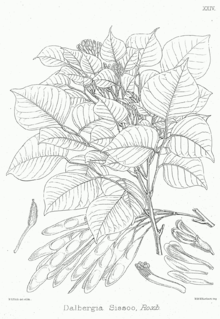Dalbergia sissoo
| Dalbergia sissoo | ||||||||||||
|---|---|---|---|---|---|---|---|---|---|---|---|---|

Dalbergia sissoo |
||||||||||||
| Systematics | ||||||||||||
|
||||||||||||
| Scientific name | ||||||||||||
| Dalbergia sissoo | ||||||||||||
| Roxb. |
Dalbergia sissoo (also Sheesham , Shisha , Shisham or Indian Rosewood ) is the state tree of the Indian state of Punjab and also the coat of arms of the Pakistani province of the same name.
description

Dalbergia sissoo is a medium to large deciduous tree with a light crown. It can reach 25 m in height and 2-3 m in diameter, but remains mostly smaller. The trunks are often overgrown when they are free-standing. The tree has a long tap root and numerous surface roots that produce numerous saplings. Young shoots are downy and drooping. Older trees have a light brown to dark gray-brown bark that is up to 2.5 cm thick and peels off in narrow strips.
The alternate leaves are leathery, pinnate and reach 15 cm in length. The flowers are whitish to pink, fragrant, almost sessile and up to 1.5 cm long. They sit in dense, 5–10 cm long bunches.
The light brown fruits are flat, thin, belt-like pods that are 4–8 cm long and 1 cm wide. They contain 1–5 flat, 8–10 mm long, bean-shaped seeds .
The heartwood is golden to dark brown, the sapwood white to pale brownish-white. Because of its high relative density of 0.7-0.8, the core is very durable and resistant to termites . However, the sapwood is easily attacked by fungi and boring insects.
The number of chromosomes is 2n = 20.
distribution
The tree is found mainly on river banks below 900 m height, but you can find it in its natural occurrence at heights of up to 1300 m. The mean temperature is 10–40 ° C, but can fluctuate between freezing point and 50 ° C. Sheesham tolerates precipitation up to 2000 mm a year , but also 3–4 months drought. It grows on sand and gravel, but also on the nutrient-rich floodplain of rivers. It also tolerates slightly salty soils.
use
Sheesham is a plantation wood from the rosewood family , which is important as a material, but also as a fuel, fodder, protection and shade tree. Since old, fully grown trees hardly exist in the past due to massive overuse, large-scale planting of sheesham trees in large plantations in the Punjab between India and Pakistan has taken place since around 1990.
The wood of these heavily fertilized, densely packed plantation trees can hardly be compared with the wood of the often centuries-old naturally grown sheesham trees. The thin trunks consist mainly of inferior sapwood, which was peeled off from old trees directly at the felling site, as it was not processed because of its straw-yellow appearance and especially its poor properties. Sheesham furniture, which is only a few years old plantation wood, consists largely of this sapwood, which is given the appearance of heartwood by coloring the finished product.
Because of its diverse uses, tolerance to light frost and long dry periods, the tree can be used for plantation management , afforestation and agro- forestry . After teak , the species is the most important forest tree in Punjab, which is also the most important supplier of the wood in Pakistan and India. In Bihar , the tree is planted as a street tree , along canals as a shade provider and as a shade tree for tea plantations. It is also often planted as a street tree in southern Indian cities such as Bangalore .
Dalbergia sissoo contains the neoflavonoid Dalbergichromen in the bark of the trunk and the heartwood .
Sheesham is a high-quality wood for carpentry and veneer production. It is also made into plywood , agricultural implements and musical instruments , can be used in skis , carving, boat building and as flooring. The castanet-like percussion instrument Khartal used in Rajasthan is often made of this wood.
The calorific value of the sapwood is approx. 20.5 MJ / kg (4908 kcal / kg), that of the heartwood approx. 21.7 MJ / kg (5181 kcal / kg). As firewood Sheesham is in a 10- to 15-year cycle beaten . The tree has good ability to erupt , although a decline in vitality is observed after two or three cycles of felling . A high-quality charcoal for heating and cooking is made from the wood .
Multiplication
The plant reproduces through root saplings , but also through seeds. The latter can only germinate for a few months. They are soaked in water for two days before sowing. 60–80% of the seeds germinate within one to three weeks. The seedlings need a sunny or partially shaded location.
toxicology
An alcoholic extract of the fruits of Dalbergia sissoo was found to be poisonous for the eggs of the freshwater snail Biomphalaria pfeifferi .
Individual evidence
- ↑ Dalbergia sissoo at Tropicos.org. In: IPCN Chromosome Reports . Missouri Botanical Garden, St. Louis
- ↑ SK Mukerjee, T. Saroja & TR Seshadri: Dalbergichromene: a new neoflavonoid from stem-bark and heartwood of Dalbergia sissoo . In: Tetrahedron . 27, No. 4, 1971, pp. 799-803. doi : 10.1016 / S0040-4020 (01) 92474-3 .
- ↑ AA Adenusi & AB Odaibo: Effects of varying Concentrations of the crude wässrige and ethanolic . In: African Journal of Traditional, Complementary and Alternative medicines . 6 (2), 2009 ( abstract , PDF ).
